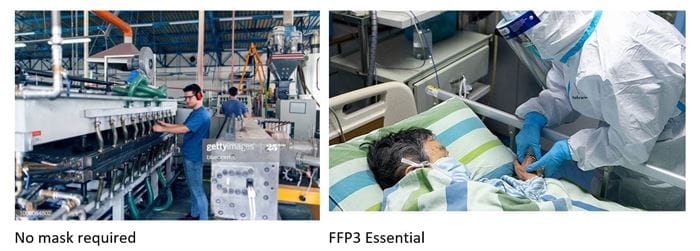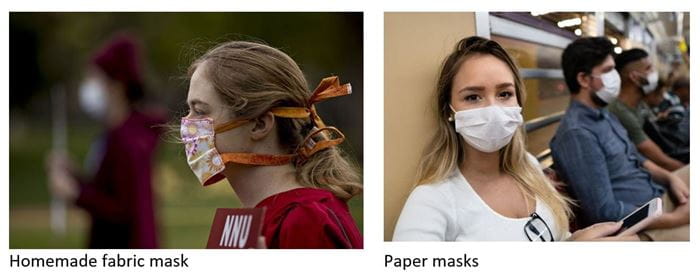Without a doubt the most common questions we are being asked by our membership at the moment relates to face masks & their use as a control measure when dealing with COVID-19 in manufacturing workplaces. What follows hopefully provides some clarity for business & helps to build the culture of confidence we believe is critical to getting UK Manufacturing back to work.
Respiratory protection in the form of disposable masks comes in three respirator ratings: FFP1, FFP2, and FFP3. FFP stands for "Filtering Face Piece" and the number denotes the level of protection. Only FFP2 and FFP3 masks protect against liquid aerosols (droplets) which is the concern when it comes to COVID-19.
The UK recommends the use of FFP3 respirators when caring for patients in areas where high risk aerosol generating procedures (AGPs) are being performed.
Most employees in a manufacturing environment are unlikely to work in this type of situation, so what type of mask is suitable and when should one be worn:

FFP2 respirators have a lower protection level than FFP3 masks. FFP2 are recommended by The World Health Organisation (WHO) for use in certain medical and patient care activities that can result in the release of airborne particles (aerosols). Again, most people outside the care community are unlikely to be exposed at work to these aerosols, but there can be exceptions, a person sneezes on you, or, in a noisy environment someone shouts instruction to you, close to your face.
There are also N95 respirators, these are made outside of the EU and are not CE marked. The HSE has put out an alert that personal protective equipment (PPE) cannot be sold or supplied as PPE unless it is CE marked. The only exception is for PPE that is organised by the UK Government for use by NHS or other healthcare workers where assessments
have been undertaken by HSE as the Market Surveillance Authority.
FFP2 and FFP3 type masks are a suitable choice for work where airborne (close contact) aerosols are a risk – Note that all masks are in short supply and if you decide to use one in a low risk environment you could be denying an NHS or other front line care worker the opportunity of being properly protected”.
Under no circumstances should N95 respirators be used as PPE. They may however be used as face coverings for travel on public transport.
- Elimination – Know your employees & understand risk of the published which groups they fit into. Ensure they are following Government rules around self-isolation.
- Substitution – Not really applicable with the virus itself, but can you do the task a different way that uses less people.
- Engineering controls – Physical barriers & screens
- Administrative controls – Social distancing rules, work patterns, personal hygiene etc.
- PPE – gloves, masks, face coverings
What about face covering?
All face covering will limit the spread of aerosol generated when you speak, shout or sneeze etc. Other than the masks specified above the covering could be a homemade mask or disposable paper mask, or even a scarf. Again, the Government has provided guidance on how you can make & wear face coverings.
By wearing a simple face covering you are protecting others should you be a person that has the illness but have yet to show any symptoms but you are not protecting yourself from infected aerosol from others.
In summary face masks & face coverings can contribute to the range of controls an employer may put in place but they all have limited effectiveness & there are many better control options further up the hierarchy.
“When managing the risk of COVID-19, additional PPE beyond what you usually wear is not beneficial. This is because COVID-19 is a different type of risk to the risks you normally face in a workplace, and needs to be managed through social distancing, hygiene and fixed teams or partnering, not through the use of PPE.”
Working safely during coronavirus (COVID-19), gov.uk
Bear in mind that there will be exceptions to the above. A first aider, for example, may need to assist a person who has collapsed, they will need an FFP3 or 2 mask and will also need a formal face fit test to be conducted. If you were a delivery driver going to other clients premises, you would need a FFP2, face fit test and training as to when to wear and how to put on and take off a mask. Maybe you are the receptionist meeting strangers, or the person carrying out health checks for your company.

So when do I need to wear a face mask or covering in a manufacturing environment?
When the 2m rule cannot be achieved, or when you do not have a screen separating you from a person who works within 1m to 2m of you may need to wear a mask. For many, this will mean that whilst you work in your cell, or at your machine/s there will be no-one near you and no need to wear a mask unless, of course, it is to protect you from other harmful substances that may be present.
It is import to note, that to contract the COVID-19 virus from an infected person who is not showing any symptoms, two workers without masks and observing the 2m rule, could talk to each other for up to 15 minutes before the level of risk begins to increase.
This is excellent news, imagine you are heading for a break and someone unexpectedly steps out in front of you, turns round and tells you to watch where you are going, even though you were not wearing a mask, you are still safe.
Three further points to know
- If you already need to wear a mask to protect you from hazardous substance, then that mask will help you protect others from you. You do not need any other mask, but you will need to clean and sanitise your existing mask more frequently.
- Second, for those that have never worn a mask, they are uncomfortable and they quickly become moist inside. A combination of darkness inside the mask and moisture will allow any viruses that get trapped in the material to survive for a long time. It is therefore important to wear the mask only when essential, this should not be more than about 15 minutes if doing physical work. Once the mask is moist, if it is reusable take it off and store it in plastic bag until it can be washed, if paper dispose of in designated waste PPE bin.
- Lastly, if you find that the mask causes you to continually touch your face and to constantly feel the need to adjust the mask, it could be putting you at greater risk than wearing no mask, you can if you wish overcome this risk by also wear a face shield.
